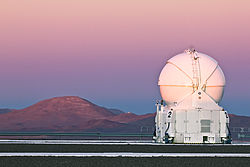Cerro Armazones
| Cerro Armazones | |
|---|---|
 | |
| Vrchol | 3046 m n. m. |
| Poloha | |
| Světadíl | Jižní Amerika |
| Stát | |
| Pohoří | Andy |
| Souřadnice | 24°35′24″ j. š., 70°11′30″ z. d. |
| Některá data mohou pocházet z datové položky. | |
Cerro Armazones je hora v pohoří Sierra Vicuña Mackenna v chilských Andách v regionu Antofagasta. Nachází se v poušti Atacama 105 km jižně od města Antofagasta a 1000 km severně od hlavního města Santiago. Na jejím vrcholku staví Evropská jižní observatoř Extrémně velký dalekohled, největší připravovaný dalekohled světa.
Hora byla původně vysoká 3 064 m. Její vrchol byl však při přípravě plošiny pro dalekohled zarovnán na výšku 3 046 m.
Na jihozápadním úpatí hory se ve výšce 2 810 m nachází od roku 1995 menší astronomická observatoř Cerro Armazones, kterou společně provozují německá Ruhr-Universität Bochum a chilská Universidad Católica del Norte.[1]
Další fotografie
Vytváření plošiny pro Extrémně velký dalekohled (rok 2015)
Cerro Armazones z 22 km vzdálené Observatoře Paranal
Odkazy
Reference
- ↑ Observatorio Cerro Armazones » About Observatorio Cerro Armazones (OCA) [online]. Universidad Católica del Norte Instituto de Astronomía [cit. 2015-04-24]. Dostupné v archivu pořízeném dne 2015-04-28. (anglicky)
Související články
Externí odkazy
 Obrázky, zvuky či videa k tématu Cerro Armazones na Wikimedia Commons
Obrázky, zvuky či videa k tématu Cerro Armazones na Wikimedia Commons
Média použitá na této stránce
Při zobrazení tohoto souboru lze snadno přidat orámování
This is a solid red equilateral triangle, which can symbolize or indicate many things, including the the symbol for fire in the books by Franz Bardon.
Autor: ESO/G.Hüdepohl (atacamaphoto.com), Licence: CC BY 4.0
At present ESO hosts three observatories in the Atacama Desert region of Chile: La Silla, Paranal and Chajnantor. Visible in the background of this image is Paranal, ESO’s flagship facility and home of the Very Large Telescope (VLT) array.
In coming years, this trio will be joined by a fourth observatory: Cerro Armazones, future site of the European Extremely Large Telescope (E-ELT). With its 39-metre-diameter mirror, the E-ELT will be the world’s biggest eye on the sky when construction is completed around 2024.
Cerro Armazones is currently only linked to Paranal by a dirt track — but, as shown in this image, construction is underway. The Chilean company ICAFAL Ingeniería y Construcción S.A. (ICAFAL) began construction in March (ann14019), and is due to take around 16 months to complete a new 7-metre-wide asphalt road. As well as carving a new road through the Chilean landscape, ICAFAL will level off the top of Cerro Armazones to create a usable platform for the E-ELT.Autor: ESO/G. Hüdepohl (www.atacamaphoto.com), Licence: CC BY 4.0
This spectacular aerial shot of Cerro Armazones, taken by ESO Photo Ambassador Gerhard Hüdepohl, represents that wonderful moment for a photographer: when everything lines up for the perfect shot.
Hüdepohl is also an electronics engineer at the European Southern Observatory’s Very Large Telescope (VLT) on Cerro Paranal, the world’s most advanced visible-light astronomical observatory and ESO’s flagship facility. Hüdepohl captured this image while on a commercial flight from Antofagasta to Santiago. Shortly after taking off the plane took the ideal flight path for an aerial snap of Cerro Armazones — and Hüdepohl could not have asked for better conditions. Seizing the moment, he was able to capture this unusual perspective, high above the spectacular terrain.
This image shows the Atacama Desert with amazing clarity, with the thin, zigzag path standing out sharply from the dusty terrain. This dirt road can be seen slicing its way up to the summit of Cerro Armazones. The site is currently occupied by a selection of surveying equipment, but it will soon become the home of the European Extremely Large Telescope (E-ELT), a 40-metre telescope that will not only answer existing questions in astronomy, but also raise — and hopefully answer — entirely new questions altogether.Autor: G. Hüdepohl/ESO, Licence: CC BY 4.0
Coated in a layer of ashen dust and littered with heavy equipment vehicles, the peak of Cerro Armazones appears conspicuously flattened as efforts continue to craft a platform for the European Extremely Large Telescope (E-ELT). This shot of the monumental work in progress was taken from a quadcopter by ESO Photo Ambassador Gerd Hüdepohl, allowing a stretch of the Chilean Coastal Range, with Cerro Paranal and the Very Large Telescope, to be unveiled as a dramatic backdrop. The Atacama Desert and its crumpled mountains unfurl outwards, dissolving into a hazy blue towards the horizon. They provide a largely featureless but quietly arresting stage for the E-ELT, which will serve as the world’s largest optical and near-infrared telescope. The clear skies of the Atacama provide the E-ELT with the perfect conditions to see the Universe with a sharpness far exceeding even that of the NASA/ESA Hubble Space Telescope. When operational, this statuesque telescope will lend its hand towards the hunt for habitable exoplanets, while also peering further back in time and space to reveal the mechanisms behind the formation of the first stars and galaxies. As with any great scientific venture, the unforeseeable discoveries that might arise also have an allure of their own. When it is completed, the E-ELT will house a 39-metre main mirror, which will collect more light than all the world’s existing 8–10-metre telescopes combined. The dome containing the telescope will stand some 74 metres in height and span 86 metres in diameter: a beast by any standards, with Cerro Armazones providing the perfect seat for this monster of modern astronomy. A video can be watched here.
Autor: ESO/G. Lombardi, Licence: CC BY 3.0
ESO Photo Ambassador Gianluca Lombardi was in the perfect position to capture a crisp dusk view of Auxiliary Telescope (AT) 2, on Cerro Paranal. Once the Sun sets, the cloudless skies above the Chilean desert will be filled with stars, and AT2 will begin its work. In the background on the left is Cerro Armazones, with a road zigzagging to its peak, home of the future European Extremely Large Telescope. Site-testing equipment can be seen on the peak. The lower peak to the right of Cerro Armazones is the site of smaller telescopes operated by the Instituto de Astronomía of the Universidad Católica del Norte.
There are four ATs on Cerro Paranal, which form part of the Very Large Telescope (VLT). They are used for a special technique called interferometry, which allows multiple ATs, or the even larger Unit Telescopes, to combine their power and see details up to 25 times finer possible than with the individual telescopes.
The round AT enclosure shown in the photo is made from two sets of three segments, which were closed at the time the picture was taken. Its job is to protect the delicate 1.8-metre telescope from the desert conditions. The enclosure is supported by the boxy transporter section, which also contains electronics cabinets, liquid cooling systems, air-conditioning units, power supplies, and more. During astronomical observations the enclosure and transporter are mechanically isolated from the telescope, to ensure that no vibrations compromise the data collected.
The transporter section runs on tracks, so the ATs can be moved to 30 different observing locations. As the VLT Interferometer (VLTI) acts rather like a single telescope as large as the group of telescopes combined, changing the positions of the ATs means that the VLTI can be adjusted according to the needs of the observing project.
Links
Autor: ESO/S. Brunier, Licence: CC BY 4.0
This night-time panorama shows Cerro Armazones in the Chilean desert, near ESO's Paranal Observatory, site of the Very Large Telescope (VLT). Cerro Armazones was chosen as the site for the planned European Extremely Large Telescope (E-ELT), which, with its 40-metre-class diameter mirror, will be the world’s biggest eye on the sky.
Autor:
- Chile_location_map.svg: NordNordWest
- derivative work: Виктор В (talk)
Location map of Chile












